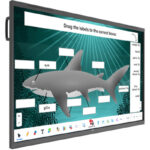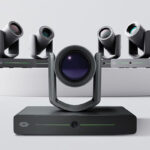AV is about great video and audio hardware that dazzles us just about everywhere we work, live, play and commute — from home, the sports arena and the museum to collaboration in the office. This ubiquity is thanks to the evolution of display technologies and DSP-powered sound gear we now have.
But AV integrators and enterprise network managers have always been concerned about the system management complexities of AV installations, streaming or collaboration content and user access/network security for AV and digital signage networks. With today’s proliferation of so many different kinds of digital displays from LCD panels and desktop monitors to smart phones, LED walls/screens and beyond — there’s more concern than ever about better managing these digitally connected ecosystems.
New content-everywhere deployments. Installation logistics. Network security. That’s enough to keep any AV provider or user awake at night. In this new age of multi-display endpoints, coupled with content delivery everywhere and all the time, it’s all too commonplace for us to be myopically focused on various parts of the overall system. We’ve now reached a critical juncture where we need to more clearly define and prioritize best practices for device management. Because the stakes are now higher for the enterprise where – after your people – your data is your most important asset. If you understand the new definition as well as the driving forces for device management, you’ll sleep better at night and be ahead of your peers or competitors in the provision and practice of great AV.
New Device Management tools are Revolutionizing AV
I’m often asked, “Isn’t device management mainly about monitoring displays?” And, in the digital-signage market, the next question I often get is, “Isn’t device management in the realm of the CMS?” Those questions were very relevant in yesterday’s AV landscape. We’ll look at them below. But the bottom line is, next-generation device management tools need to do so much more. They need to enable better ways to improve installation logistics and efficiency while also mitigating network security risks in the new AV/IT InfoSec landscape. As Smart Displays with Computer Systems on Chip (SoC) continue to proliferate, end customers increasingly require these devices to be secured and managed just like any other IoT device on their networks.
Let’s look at the CMS question. In digital-signage deployments, the CMS refers to the content management system. After you’ve installed your screens for your digital signage network whether five screens or 5,000 — you need a CMS to feed the content to all those beautiful displays. Generally, there are two kinds: Cloud-based CMS with a subscription fee or on-premise CMS hosted on your physical servers. With either, digital-signage challenges often revolve around two key pain points: remote management capabilities for all of your screens, and network security issues.
“Remote management” circles back to that question: “Is device management mainly about monitoring displays?” The answer: device management and monitoring are not the same. Many digital signage CMSs have monitoring functions, but they focus on monitoring player status, and perhaps with added layers of platform configuration management, remote control of players and content playout reporting. Not all CMS offerings are created equal. In fact, some have more layers of remote management than others. More importantly, some have higher levels of integrations with third-party device management tools than others.
So where are we now, in AV and digital signage? We’re at a key point where top designers and network operators are seeing the benefits of having separate CMS and device management platforms. Why? Because monitoring, while important, is not where the new key pain points lie.
Also Read: Is Audio a Key Growth Area for Your AV Services?
Device Management Best Practices to Alleviate AV Pain Points
Today, it’s crucial to accomplish these things first, in your AV ecosystem:
Save Time and Money on Installation
You need to have a cost-efficient, rapid provisioning process for all your screens, in the installation phase. Today’s best device management platforms start paying off before you go live. On many AV installations, labor and therefore, money is wasted just installing and provisioning your flat panel screens. It’s critical to reduce time and labor spent in this process. So, the device management platform needs to focus first on provisioning your screens. Downstream flexibility requirements also continue to accelerate as service providers and end customers elect to implement solutions that support a range of software options and allow deployments to evolve as capabilities and requirements develop over time.
More mature end users also have come to realize that device management previously benefitting their digital signage displays can also substantially benefit other applications such as conference and collaboration solutions, where a CMS typically would not be deployed.
This has led many of the most demanding AV integrators and end users to choose separate device management tools, not using the ones tied to a specific CMS company’s offerings. This is because the latter probably won’t help the more display-centric functions like turning devices on and off, rebooting devices, installing or upgrading software packages remotely, or defining screen orientation (portrait or landscape and even other configurations).
Reduce Network Risk
Enhance your Confidentiality, Integrity and Availability (CIA) risk mitigation strategies across both, the content network as well as the host company’s IT network. The security risks have only increased in urgency today because so many smart devices are being added to networks.
End customer networks are often a veritable circus of IoT devices starting with smartphones and desktop workstations, to LCD flat panels (many with SoC, i.e. they’re “smart” displays) and large LED video walls to even smart building sensors. Having so many smart devices on the network presents security risks. More devices mean more potential vulnerabilities — that’s why Infosec needs are key to the device management puzzle. Fortunately, new generation device management tools, such as Sony’s new Device Management Platform, help you not just “manage endpoints,” but ensure risks are mitigated and device data traffic is logged.
InfoSec, AV and CIA Triad
In the AV world, we’ve typically used the term network security when talking about the need to protect networks and data. Start looking for more references to InfoSec, i.e. Information Security. It’s becoming more critical daily, and it’s about the protection of information systems from unauthorized access, use, disclosure, theft, disruption, modification or destruction. It’s often framed in terms of the CIA Triad — Confidentiality, Integrity and Availability — and is a guiding model for security strategies, policies and controls that minimize threats to those three crucial components.
InfoSec is a growing area of concern as AV and IT have largely converged, and more screen-based and other AV devices are attached to the IT backbone. Does this make the network less secure? New device management tools now enable not just better control and monitoring of AV devices but, crucially, a more secure connection to the network so that information security risk is mitigated at all levels. Best practices in AV now include these InfoSec protocols from the start of the project through years of ongoing use.
Don’t Overlook New Sustainability Mandates
Choosing the right device management platform not only substantially reduces installation time, resource demand and complexity for Managed Service Providers, but it also helps contribute to users’ sustainability goals by reducing the need for operators, technicians and support personnel to travel on-site, which can translate to a smaller carbon footprint. Device management platforms can be also used to programmatically reduce brightness and turn displays on and off to meet operational requirements, helping reduce power consumption.
The Road Ahead
A network can now include many kinds of endpoint terminals: traditional LCD panels, LED as well as desktops and smartphones. So many of those, not just personal devices, are “smart” devices, and that will only get more complicated over time. How can you help Managed Service Providers and end users more efficiently provision and roll out AV networks while also better addressing ongoing device management and security needs once the system is up and running?
The first thing you should ask your device management platform provider is “Can you make installation of the system more efficient and less labor intensive?” And “How can you help lock down all devices for better security?” You’ll be amazed at what’s possible when investing smartly in today’s new toolsets.
 Terrence Boyd, senior strategy and business development manager, holds nearly 16 years of experience in diverse and varied roles at Sony Electronics where he specializes in recognizing synergies between companies, facilitating partnerships that unlock mutual growth opportunities, foster connections and drive prosperity.
Terrence Boyd, senior strategy and business development manager, holds nearly 16 years of experience in diverse and varied roles at Sony Electronics where he specializes in recognizing synergies between companies, facilitating partnerships that unlock mutual growth opportunities, foster connections and drive prosperity.










